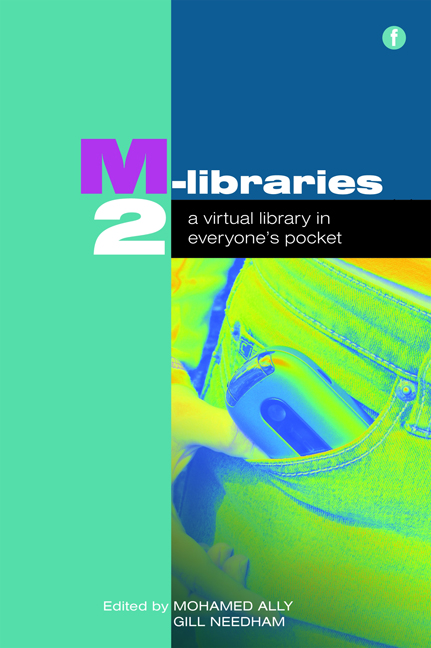Book contents
- Frontmatter
- Contents
- Acknowledgements
- Contributors
- Foreword
- Introduction
- PART 1 M-LIBRARIES: DEVELOPMENTS AROUND THE WORLD
- PART 2 TECHNOLOGY IN M-LIBRARIES
- 6 Evolution of modern library services: the progression into the mobile domain
- 7 Bibliographic ontology and e-books
- 8 QR codes and their applications for libraries: a case study from the University of Bath Library
- 9 A tale of two institutions: collaborative approach to support and develop mobile library services and resources
- 10 Designing a mobile device automatic detector to support mobile library systems
- 11 The Athabasca University Library Digital Reading Room: an iPhone prototype implementation
- PART 3 APPLICATION OF M-LIBRARIES
- PART 4 M-LIBRARIES AND LEARNING
- PART 5 BUILDING THE EVIDENCE BASE FOR M-LIBRARIES
- Conclusion
- Index
10 - Designing a mobile device automatic detector to support mobile library systems
from PART 2 - TECHNOLOGY IN M-LIBRARIES
Published online by Cambridge University Press: 08 June 2018
- Frontmatter
- Contents
- Acknowledgements
- Contributors
- Foreword
- Introduction
- PART 1 M-LIBRARIES: DEVELOPMENTS AROUND THE WORLD
- PART 2 TECHNOLOGY IN M-LIBRARIES
- 6 Evolution of modern library services: the progression into the mobile domain
- 7 Bibliographic ontology and e-books
- 8 QR codes and their applications for libraries: a case study from the University of Bath Library
- 9 A tale of two institutions: collaborative approach to support and develop mobile library services and resources
- 10 Designing a mobile device automatic detector to support mobile library systems
- 11 The Athabasca University Library Digital Reading Room: an iPhone prototype implementation
- PART 3 APPLICATION OF M-LIBRARIES
- PART 4 M-LIBRARIES AND LEARNING
- PART 5 BUILDING THE EVIDENCE BASE FOR M-LIBRARIES
- Conclusion
- Index
Summary
Abstract
Content providers cannot ensure that digital material will be reformatted and accessed by any mobile device correctly, due to mobile device limitations. A mobile device automatic detector can provide accurate information about devices accessing mobile library systems. This information can be used to properly render content for the specific device. This chapter proposes an approach to designing a detector that will support mobile library systems so as to render web content dynamically and adaptively. The overall architecture of the detector is also discussed in this chapter and follows from a simple experimental study to evaluate the design proposed here.
Introduction
The rapid adoption of mobile devices with internet capabilities has allowed users to work or study at any time, in any place (Motiwalla, 2007). There have also been descriptions of implementations of library access via mobile devices (Needham and Ally, 2008; Yang et al., 2006). However, there are many limitations to mobile devices, which greatly restrict the relevant applications of mobile technology (Ally et al., 2006; Kojiri et al., 2007). Although some content providers have designed purposely digital material for mobile learning, providers cannot ensure that content is able to be correctly reformatted and accessed by any mobile device. This is due to the diverse characteristics among devices, which are not taken into account by most ubiquitous learning systems (Yang, 2007; Motiwalla, 2007). Some early attempts made effective use of proxy servers (Cheung et al., 2007)
In any case, either with proxies or by other detection methods, it is essential to provide adaptive content based on the characteristics of mobile learners and mobile devices. In this chapter an automatic mobile device detector for mobile library systems is proposed to support content designers. This detector will provide adaptive content based on the capabilities of different mobile devices. This investigation concerns and is limited to the characteristics of the mobile devices. Learners’ characteristics may also affect adaptive content.
The aim of this research is to construct an architecture that detects features of mobile devices, create RDFS (Resource Description Framework Schema) formatted mobile device profiles and provide content designers with services that are relevant to the mobile device profile. Constructing the mobile device profile is a great challenge for mobile library systems, the most difficult part being the immediate and accurate collection of mobile device features when content is accessed via the world wide web.
- Type
- Chapter
- Information
- M-Libraries 2A virtual library in everyone's pocket, pp. 97 - 108Publisher: FacetPrint publication year: 2010



